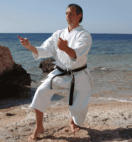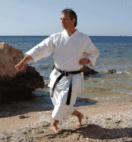karatekata
Wado-Ryu
Hironori
Otsuka
was
one
of
the
first
students
of
Gichin
Funakoshi.
As
a
student
of
Jiu
Jitsu
probably
he
found
his
way
to
Funakoshi
by
Judo
master
Jiro
Kano,
who
was
highly
interest
in
Karate.
Otsuka
got
master
degree
in
short
time.
After
caming
in
contact
with
Kenwa
Mabuni
he
did
start
to
study
Shito
Ryu.
Most
of
the
Wado
Ryu
Kata
are
based
on
Shito
Ryu.
So
he
took
the
5
Heian
Kata
under
their okinawan name Pinan.
The Naihanchi is identical to Naihanchin Shodan and far away to be the old original Naihanchi.
Same
is
for
Bassai
which
is
Bassai
Dai.
The
Kushanku
is
identical
to
Kosokun
Dai
but
also
includes
some techniques of Kanku Dai.
Seishan is identical to Hangetsu.
Chinto is similar to Shito Ryu Chinto and is known as the highest Kata of Wado Ryu.
This was the fundamental curriculum of Kata of the style. More Kata has been added later.
As
Otsuka
made
Wado
Ryu
public
it
was
highly
welcome
in
Japan.
Because
Otsuka
was
Japan,
while Funakoshi and Mabuni came from Okinawa. So it was a homegame.
Wado Ryu is close to real combat situations. Especially Tai Sabaki plays a main role.
The
fact
that
the
defense
against
knife
attack
is
an
important
part
can
make
as
think
that
street
fighting was a theme in Otsuka's work.
In
his
time
it
was
not
common
to
be
attacked
on
the
road
by
traditinal
weapons
like
sword,
Bo,
Tonfa, Sai.
Much
more
probably
was
the
attack
with
a
knife.
In
fact
a
knife
is
a
dangerous
weapon.
Easy
to
carry and difficult to defeat.
Like
Sokon
Matsumura
the
legendary
grandmaster
of
Shuri-te,
Otsuka
may
have
found
the
conclusion that Tai Sabaki is a good way to stand out of the way of any attack.
So Wado Ryu seems to be close to the ideas of the okinawan roots.
This
makes
Wado
Ryu
less
attractiv
on
the
sportive
scene.
And
in
fact
in
Kata
competition
it's
plays
no role.
But for the value of the style this has no meaning.
The
interest
on
the
old
way
is
maybe
the
reason
why
some
Wado
Ryu
masters
are
interest
in
old
Kata which not part of Wado Ryu, like Happoren or Rokkishu.
Hironori
Otsuka
changed
the
Kata
of
Wado-Ryu
based
on
his
studies
of
Shotokan
teached
by
Gichin
Funakoshi and the Shito-Ryu of Kenwa Mabuni. Though the influence of Shito-Ryu is more visible.
In
the
beginning
the
Pinan
Kata,
the
Naifanchin
(Shodan),
the
Seishan,
Kushanku
an
Chinto
was
included in the style.
More
Kata
has
been
added
later.
In
present
time
some
schools
using
more
Kata.
Some
do
Suparimpei.
Bassai
The Kata is similar to the Shito-Ryu Version. Only the end with Mikazuki Geri, Kosa Uke and the
following Yama zukis we find in the Shotokan version
Chinto
The difference to the Shito-Ryu version is only by the performance of the techniques
Jion
This Jion is nearly identical the version of Shito-Ryu. But in Wado Ryu style a Gyaku Age Uke has
been added. So we see the combination Age Uke, Gyaku Age Uke, Choku zuki instead for Age Uke,
Gyaku zuki
Jitte
Jitte is also in mainpart identical to the Shito-Ryu version. Just the beginning is more similiar to the
Shotokan Jitte
Kushanku
The Kushanku is close to the Kosokun Dai of Shito-Ryu. So it's not to compare with Chantanyara
Kushanku. But some movements are done on the way of Shotokan Kanku Dai
Naihanchi
The Naihanchi ist close to the Naifanchin Shodan. But in some parts, which is especially to see in
the combination with Uraken Uchi, it's changed
Niseishi
The Kata is nearly identical with the Nijushiho of Shotokan. Just the Age Uke with following Gykau
Tate Empi is done straight direction instead of the sidewise version of Shotokan
Pinan Shodan
The Pinan Kata of Wado-Ryu are similiar to the Heian Kata of Shito-Ryu. The differences are less
and mainly to see in the stances and movements of the legs. Also the Yoko Uke and Shuto Uke will
be done in Jodan area
Identical to Shito Ryu Heian Shodan (Shotokan Heian Nidan)
Pinan Nidan
Identical to Shito Ryu Heian Nidan (Shotokan Heian Shodan)
Pinan Sandan
Identical to Shito Ryu Heian Sandan
Pinan Yondan
Identical to Shito Ryu Heian Yondan
Pinan Godan
Identical to Shito Ryu Heian Godan
Rohai
This Rohai is identical with the Rohai Shodan of Shito-Ryu
Seishan
There are nearly no differences between this Seishan and the Hangetsu of Shotokan. It's only the
performance of the techniques and more movements done slowy
Wanshu
The only difference between Wansu and Shotokan Kata Empi is, that after the Gyaku zuki in Kosa
Dachi instead for the Ushiro Gedan Barai a Gedan Barai in Zenkutsu Dachi will be done in the same
direction as the Gyaku zuki before.







karatekata

Wado-Ryu
Hironori
Otsuka
was
one
of
the
first
students
of
Gichin
Funakoshi.
As
a
student
of
Jiu
Jitsu
probably
he
found
his
way
to
Funakoshi
by
Judo
master
Jiro
Kano,
who
was
highly
interest
in
Karate.
Otsuka
got
master
degree
in
short
time.
After
caming
in
contact
with
Kenwa
Mabuni
he
did
start
to
study
Shito
Ryu.
Most
of
the
Wado
Ryu
Kata
are
based
on
Shito
Ryu.
So
he
took
the
5
Heian
Kata
under
their
okinawan name Pinan.
The
Naihanchi
is
identical
to
Naihanchin
Shodan
and
far
away
to
be
the
old
original
Naihanchi.
Same
is
for
Bassai which is Bassai Dai.
The
Kushanku
is
identical
to
Kosokun
Dai
but
also
includes
some
techniques of Kanku Dai.
Seishan is identical to Hangetsu.
Chinto
is
similar
to
Shito
Ryu
Chinto
and
is
known
as
the
highest
Kata of Wado Ryu.
This
was
the
fundamental
curriculum
of
Kata
of
the
style.
More
Kata has been added later.
As
Otsuka
made
Wado
Ryu
public
it
was
highly
welcome
in
Japan.
Because
Otsuka
was
Japan,
while
Funakoshi
and
Mabuni
came from Okinawa. So it was a homegame.
Wado
Ryu
is
close
to
real
combat
situations.
Especially
Tai
Sabaki
plays a main role.
The
fact
that
the
defense
against
knife
attack
is
an
important
part
can
make
as
think
that
street
fighting
was
a
theme
in
Otsuka's work.
In
his
time
it
was
not
common
to
be
attacked
on
the
road
by
traditinal weapons like sword, Bo, Tonfa, Sai.
Much
more
probably
was
the
attack
with
a
knife.
In
fact
a
knife
is a dangerous weapon. Easy to carry and difficult to defeat.
Like
Sokon
Matsumura
the
legendary
grandmaster
of
Shuri-te,
Otsuka
may
have
found
the
conclusion
that
Tai
Sabaki
is
a
good
way to stand out of the way of any attack.
So
Wado
Ryu
seems
to
be
close
to
the
ideas
of
the
okinawan
roots.
This
makes
Wado
Ryu
less
attractiv
on
the
sportive
scene.
And
in
fact in Kata competition it's plays no role.
But for the value of the style this has no meaning.
The
interest
on
the
old
way
is
maybe
the
reason
why
some
Wado
Ryu
masters
are
interest
in
old
Kata
which
not
part
of
Wado
Ryu,
like Happoren or Rokkishu.
Hironori
Otsuka
changed
the
Kata
of
Wado-Ryu
based
on
his
studies
of
Shotokan
teached
by
Gichin
Funakoshi
and
the
Shito-
Ryu
of
Kenwa
Mabuni.
Though
the
influence
of
Shito-Ryu
is
more
visible.
In
the
beginning
the
Pinan
Kata,
the
Naifanchin
(Shodan),
the
Seishan, Kushanku an Chinto was included in the style.
More
Kata
has
been
added
later.
In
present
time
some
schools
using more Kata. Some do Suparimpei.
Bassai
The Kata is similar to the Shito-Ryu Version. Only the end with
Mikazuki Geri, Kosa Uke and the following Yama zukis we find in
the Shotokan version
Chinto
The difference to the Shito-Ryu version is only by the
performance of the techniques
Jion
This Jion is nearly identical the version of Shito-Ryu. But in Wado
Ryu style a Gyaku Age Uke has been added. So we see the
combination Age Uke, Gyaku Age Uke, Choku zuki instead for
Age Uke, Gyaku zuki
Jitte
Jitte is also in mainpart identical to the Shito-Ryu version. Just
the beginning is more similiar to the Shotokan Jitte
Kushanku
The Kushanku is close to the Kosokun Dai of Shito-Ryu. So it's
not to compare with Chantanyara Kushanku. But some
movements are done on the way of Shotokan Kanku Dai
Naihanchi
The Naihanchi ist close to the Naifanchin Shodan. But in some
parts, which is especially to see in the combination with Uraken
Uchi, it's changed
Niseishi
The Kata is nearly identical with the Nijushiho of Shotokan. Just
the Age Uke with following Gykau Tate Empi is done straight
direction instead of the sidewise version of Shotokan
Pinan Shodan
The Pinan Kata of Wado-Ryu are similiar to the Heian Kata of
Shito-Ryu. The differences are less and mainly to see in the
stances and movements of the legs. Also the Yoko Uke and
Shuto Uke will be done in Jodan area
Identical to Shito Ryu Heian Shodan (Shotokan Heian Nidan)
Pinan Nidan
Identical to Shito Ryu Heian Nidan (Shotokan Heian Shodan)
Pinan Sandan
Identical to Shito Ryu Heian Sandan
Pinan Yondan
Identical to Shito Ryu Heian Yondan
Pinan Godan
Identical to Shito Ryu Heian Godan
Rohai
This Rohai is identical with the Rohai Shodan of Shito-Ryu
Seishan
There are nearly no differences between this Seishan and the
Hangetsu of Shotokan. It's only the performance of the
techniques and more movements done slowy
Wanshu
The only difference between Wansu and Shotokan Kata Empi is,
that after the Gyaku zuki in Kosa Dachi instead for the Ushiro
Gedan Barai a Gedan Barai in Zenkutsu Dachi will be done in the
same direction as the Gyaku zuki before















































































